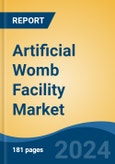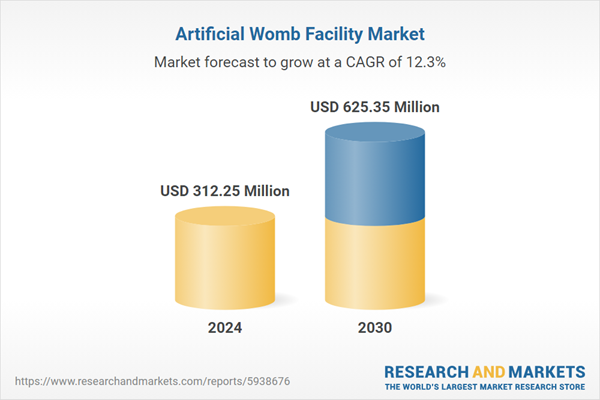Speak directly to the analyst to clarify any post sales queries you may have.
10% Free customizationThis report comes with 10% free customization, enabling you to add data that meets your specific business needs.
An artificial womb, also known as an ectogenesis chamber, is a device that replicates the conditions of a natural womb to support the growth and development of a fetus outside of a human body. It aims to provide a controlled environment where a preterm or at-risk fetus can continue to develop until it reaches a viable stage, potentially reducing the complications associated with premature births. These devices can be instrumental in alleviating various medical and ethical challenges associated with traditional pregnancies.
Key Market Drivers
Reduction in Maternal Mortality is Driving the Global Artificial Womb Facility Market
Maternal mortality, a tragic and largely preventable occurrence, has long been a global concern. The World Health Organization (WHO) defines maternal mortality as the death of a woman during pregnancy, childbirth, or within 42 days of termination of pregnancy, irrespective of the duration and site of the pregnancy. While significant progress has been made in reducing maternal mortality rates worldwide, it continues to be a critical issue, particularly in developing countries. As we strive for better healthcare outcomes, one innovative solution is emerging as a potential game-changer: the artificial womb facility. This technology has the potential to significantly reduce maternal mortality and drive the global artificial womb facility market.Maternal mortality is a multifaceted problem that reflects not only the health of women but also the accessibility and quality of healthcare services. The root causes of maternal mortality are varied and complex, including inadequate prenatal care, limited access to healthcare facilities, cultural and social factors, and medical complications during pregnancy and childbirth. According to the WHO, approximately 810 women die every day from preventable causes related to pregnancy and childbirth. This equates to over 295,000 maternal deaths annually. Artificial wombs, often referred to as "ectogenesis," are a groundbreaking technological development in the field of reproductive medicine.
These devices aim to provide an environment outside the human body where a developing fetus can thrive. While still in the experimental stage, artificial wombs hold the promise of transforming reproductive healthcare by reducing the risks associated with pregnancy and childbirth. One of the most significant advantages of artificial wombs is the potential to eliminate many of the risks that pregnant women face during the gestational period. Maternal mortality often results from complications related to pregnancy, including preeclampsia, hemorrhage, infections, and obstructed labor. With artificial wombs, the fetus can be safely nurtured outside the mother's body, reducing the risk of these life-threatening complications.
Key Market Challenges
Ethical and Moral Concerns
The ethical and moral concerns surrounding artificial wombs are significant and complex. Questions about when life begins, the potential for misuse, and the creation of a dystopian society where human reproduction is entirely divorced from natural processes have raised red flags among many stakeholders. Striking a balance between technological progress and ethical considerations is a daunting task that the market must confront.Key Market Trends
Technological Advancements
Technological advancements have played a pivotal role in transforming various aspects of our lives. In recent years, these advancements have extended their reach into the field of healthcare and, specifically, artificial womb technology. The development and adoption of artificial womb facilities are on the rise, driven by increasing technological innovations, which have the potential to revolutionize the way we care for premature babies and address various reproductive health challenges. The progress in biotechnology has led to significant breakthroughs in artificial womb technology.Biocompatible materials, improved incubation systems, and better understanding of fetal development have made it possible to create an environment that closely mimics the mother's womb. Artificial placenta systems have been developed to provide the necessary oxygen and nutrients to the developing fetus, effectively bypassing the need for a natural placenta. This breakthrough technology is a game-changer for the care of premature infants. Technological advancements have allowed for the miniaturization of components, making artificial womb facilities more compact and efficient. This portability can potentially enable care for premature infants in various healthcare settings.
Key Market Players
- American University of Beirut (AUB)
- Biotex Inc.
- California Preterm Birth Initiative
- Emmaus Life Sciences, Inc.
- Hebrew University
- Institute of Life Sciences
- Juno Perinatal Healthcare
- Sera Prognostics, Inc.
- Shanghai First Maternity and Infant Hospital
- SomaGenics Inc.
Report Scope:
In this report, the Global Artificial Womb Facility Market has been segmented into the following categories, in addition to the industry trends which have also been detailed below:Artificial Womb Facility Market, By Technology:
- Bioreactors
- Extrauter in Support Devices
- Others
Artificial Womb Facility Market, By Application:
- Prenatal Care
- Neonatal Care
Artificial Womb Facility Market, By End user:
- Super Specialty Hospitals
- Research Centers
- In-Vitro Fertilization Centers (IVF)
Artificial Womb Facility Market, By Region:
- North America
- United States
- Canada
- Mexico
- Europe
- France
- United Kingdom
- Italy
- Germany
- Spain
- Asia-Pacific
- China
- India
- Japan
- Australia
- South Korea
- South America
- Brazil
- Argentina
- Colombia
- Middle East & Africa
- South Africa
- Saudi Arabia
- UAE
Competitive Landscape
Company Profiles: Detailed analysis of the major companies present in the Artificial Womb Facility Market.Available Customizations:
With the given market data, the publisher offers customizations according to a company's specific needs. The following customization options are available for the report.Company Information
- Detailed analysis and profiling of additional market players (up to five).
This product will be delivered within 1-3 business days.
Table of Contents
Companies Mentioned
- American University of Beirut (AUB)
- Biotex Inc.
- California Preterm Birth Initiative
- Emmaus Life Sciences, Inc.
- Hebrew University
- Institute of Life Sciences
- Juno Perinatal Healthcare
- Sera Prognostics, Inc.
- Shanghai First Maternity and Infant Hospital
- SomaGenics Inc.
Table Information
| Report Attribute | Details |
|---|---|
| No. of Pages | 180 |
| Published | March 2025 |
| Forecast Period | 2024 - 2030 |
| Estimated Market Value ( USD | $ 312.25 Million |
| Forecasted Market Value ( USD | $ 625.35 Million |
| Compound Annual Growth Rate | 12.2% |
| Regions Covered | Global |
| No. of Companies Mentioned | 10 |









